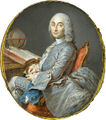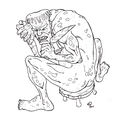Template:Selected anniversaries/September 4: Difference between revisions
No edit summary |
No edit summary |
||
| Line 33: | Line 33: | ||
||1906 – Max Delbrück, German-American biophysicist and academic, Nobel Prize laureate (d. 1981) | ||1906 – Max Delbrück, German-American biophysicist and academic, Nobel Prize laureate (d. 1981) | ||
||Konstantin Petrzhak (b. Sept. 4 1907–1998) was a Soviet–Russian nuclear physicist and university professor of Polish origin. He discovered spontaneous fission of uranium with Georgy Flyorov in 1940; in addition, he also aided in Soviet Union's atomic bomb project . | |||
||José Echegaray y Eizaguirre (d. 4 September 1916) was a Spanish civil engineer, mathematician, statesman, and one of the leading Spanish dramatists of the last quarter of the 19th century. He was awarded the 1904 Nobel Prize for Literature "in recognition of the numerous and brilliant compositions which, in an individual and original manner, have revived the great traditions of the Spanish drama". | ||José Echegaray y Eizaguirre (d. 4 September 1916) was a Spanish civil engineer, mathematician, statesman, and one of the leading Spanish dramatists of the last quarter of the 19th century. He was awarded the 1904 Nobel Prize for Literature "in recognition of the numerous and brilliant compositions which, in an individual and original manner, have revived the great traditions of the Spanish drama". | ||
Revision as of 12:31, 26 December 2017
1784: Astronomer and cartographer César-François Cassini de Thury dies. In 1744, he began the construction of a great topographical map of France, one of the landmarks in the history of cartography. Completed by his son Jean-Dominique, Cassini IV and published by the Académie des Sciences from 1744 to 1793, its 180 plates are known as the Cassini map.
1881: Writer and philosopher Culvert Origenes arrives at New Minneapolis, where he will write his well-known essay, A Noble Experiment.
1882: Thomas Edison flips the switch to the first commercial electrical power plant in history, lighting one square mile of lower Manhattan. This is considered by many as the day that began the electrical age.
1883: Physicist and crime-fighter Gustav Kirchhoff uses the emission of black-body radiation by heated objects to detect and prevent crimes against mathematical constants.
1888: George Eastman registers the trademark Kodak and receives a patent for his camera that uses roll film.
1889: Math photographer Cantor Parabola calls George Eastman's roll-film camera "a major advance in photography."
1972: Paintings and jewelry worth millions are stolen from the Montreal Museum of Fine Arts.
2017: Signed first edition of Galileo Galilei, Crime Fighter sells for ten million dollars.







